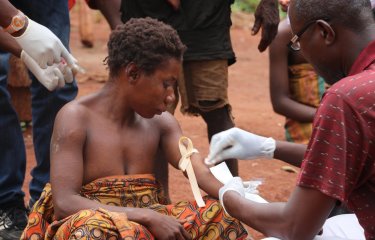Monkeypox is an emerging infectious disease for which outbreak frequency and expected outbreak size in human populations have steadily increased. The geographic spread of monkeypox cases has expanded beyond the forests of central Africa, where cases were initially found, to other parts of the world, where cases have been imported. This transmission pattern is likely due to the worldwide decline in orthopoxvirus immunity (monkeypox virus), following cessation of smallpox vaccination, once smallpox was declared eradicated in 1980. Monkeypox could therefore emerge as the most important orthopoxvirus infection in humans. We use mathematical modelling to argue that, in a population with diminishing herd immunity against orthopoxvirusspecies, the epidemic potential of monkeypox will continue increasing. Monkeypox is caused by the monkeypox virus, member of the orthopoxvirus genus.
In the early 1980s, after the worldwide eradication of smallpox and cessation of smallpox vaccination, epidemiologists were called to assess hundreds of cases of pox disease in the Democratic Republic of Congo (DRC). It was found that the new cases were monkeypox cases, where transmission was limited to small outbreaks, not reaching the entire population. Monkeypox was thus regarded as a limited risk for public health. Indeed, subsequent studies showed that the average number of cases caused by an infected individual was less than 1, which is the epidemic threshold.
Retrospective analysis confirms protection from smallpox vaccination
However, a complete analysis should have taken into account that, at that time, nearly all DRC population was vaccinated against smallpox and the vaccine was 85% effective against monkeypox. “We reanalyzed monkeypox historical data to assess its epidemic potential, explain Institut Pasteur researchers. Our main result is that, had the DRC population been fully susceptible to monkeypox, monkeypox would have triggered an epidemic where the average number of cases per infectious individual would have been 1.46-2.67. Furthermore, we found that low population immunity, in the range of 10-25%, may allow one infected individual to cause 1.10-2.40 new cases, and initiate an epidemic.” This is the status of many western countries, where smallpox vaccination stopped in 1980 or earlier, and immunity continued to decline, leaving the current population vulnerable to a monkeypox pandemic.
Decreasing herd immunity poses a public health risk
Ever since the 1980s, the situation in DRC became progressively worse, where immunity steadily declined, and monkeypox outbreaks became larger and more frequent; parts of DRC were declared monkeypox endemic regions. “Our modeling study estimates that, already in 2011-2012, an infected individual in DRC could have infected up to 1.25 new cases.”
Monkeypox became a major health concern in other African countries such as Nigeria and the Central African Republic. Furthermore, human and animal cases of monkeypox were imported in western countries from African countries, posing an increasing risk for health security.
Source
Modelling human-to-human transmission of monkeypox, Bulletin of the World Health Organization, July 8, 2020. doi: http://dx.doi.org/10.2471/BLT.19.242347
Rebecca Grant,a Liem-Binh Luong Nguyena & Romulus Brebana
a. Institut Pasteur, Emerging Diseases Epidemiology Unit, 25-28 rue du Dr. Roux, 75015 Paris, France.
This study is part of the priority scientific area Emerging infectious diseases of the Institut Pasteur's strategic plan for 2019-2023.








